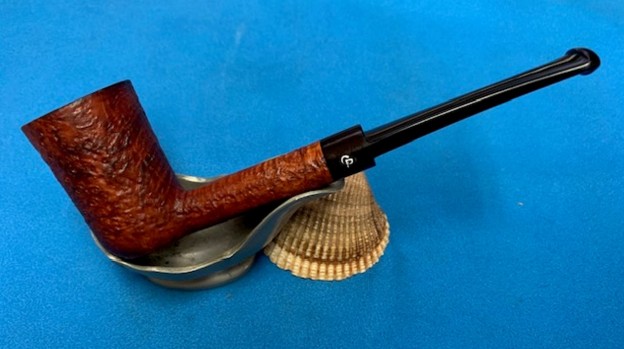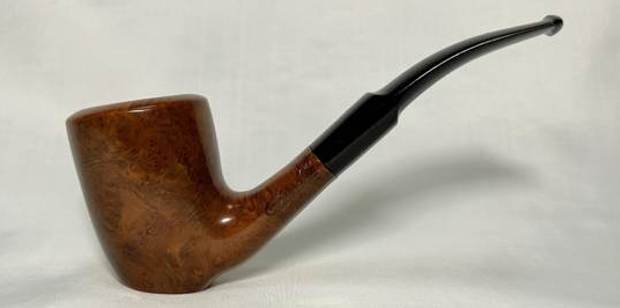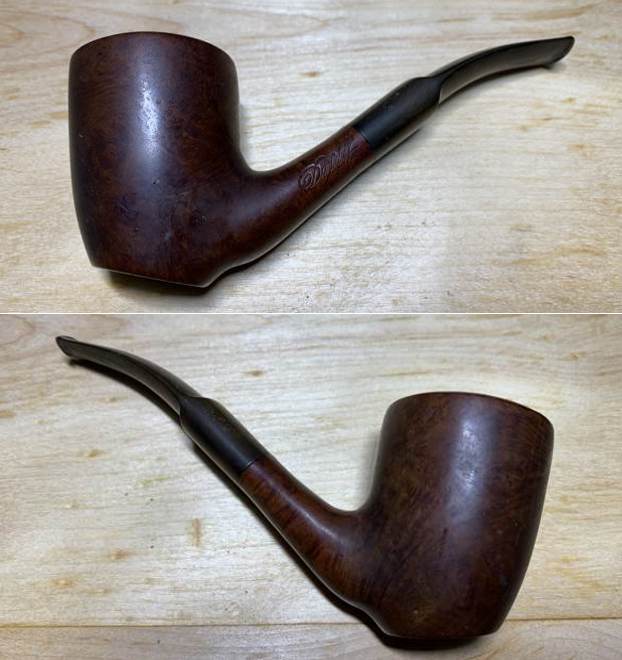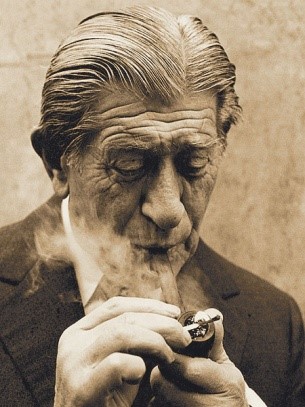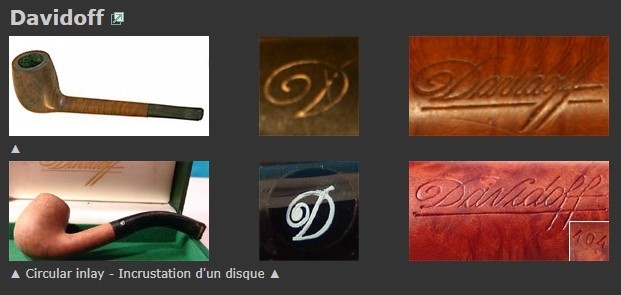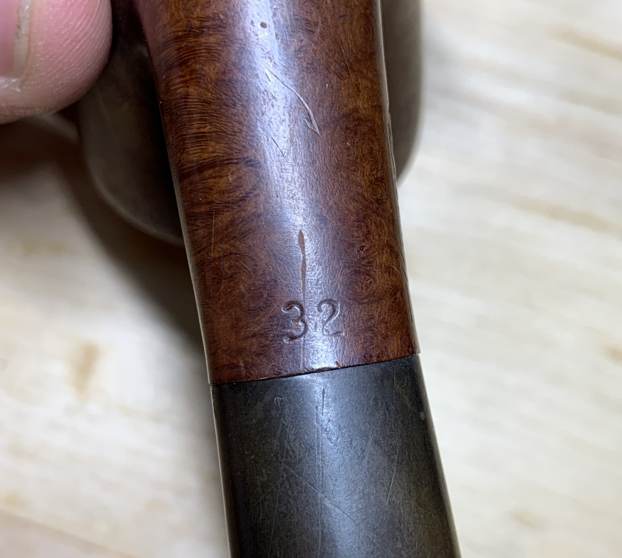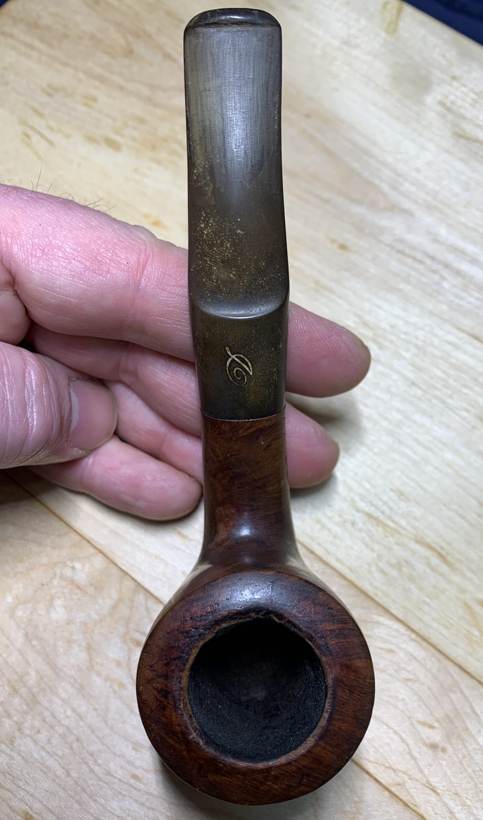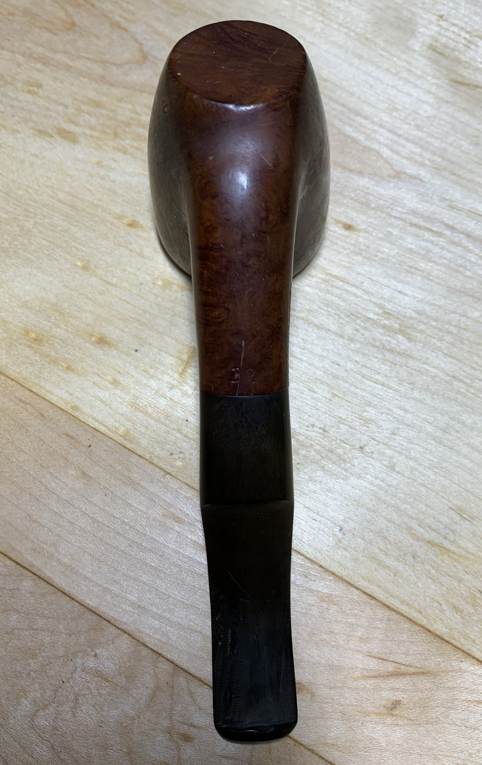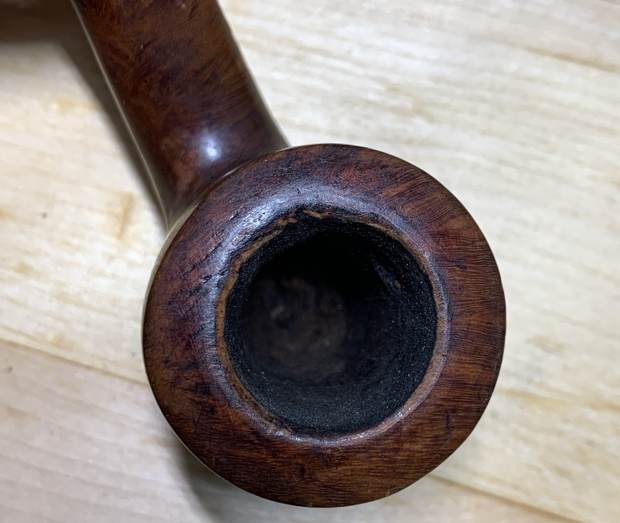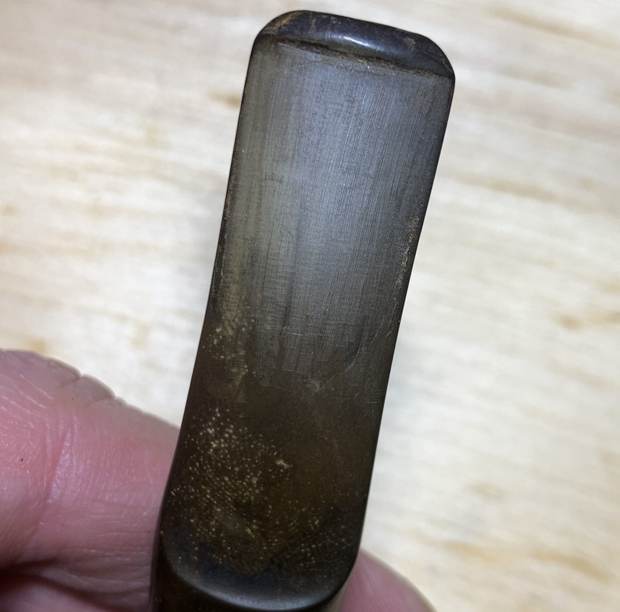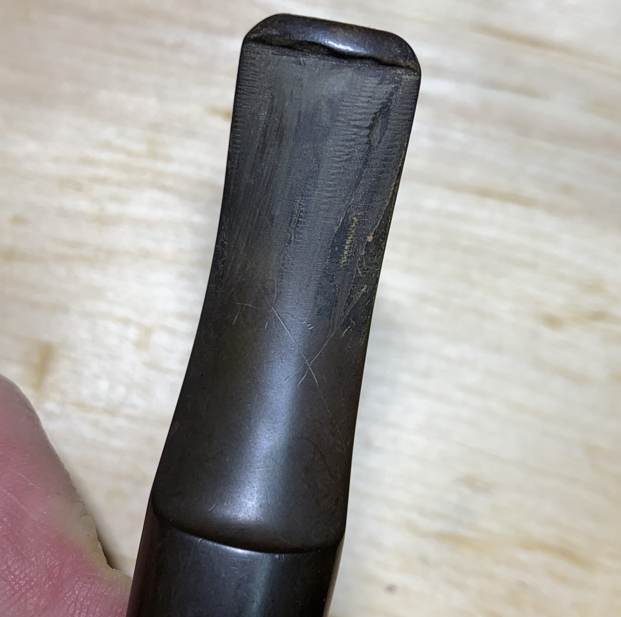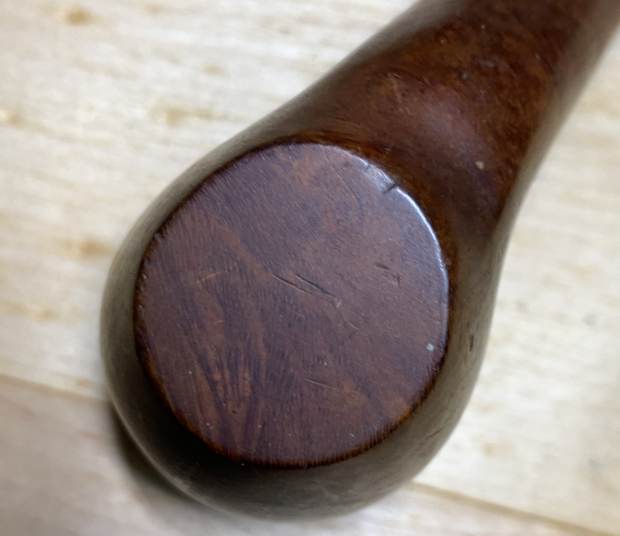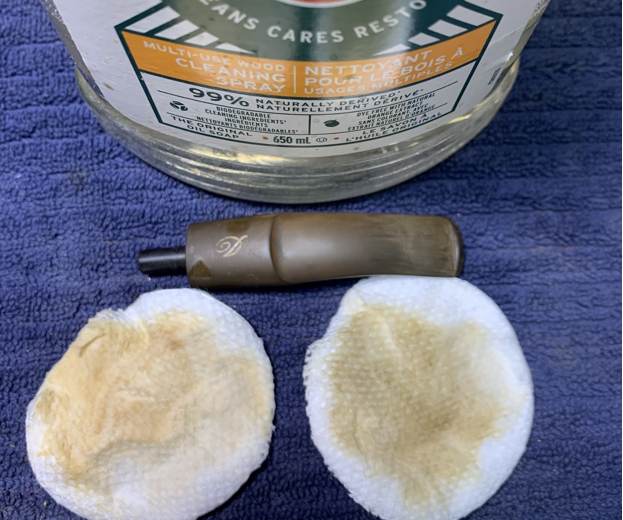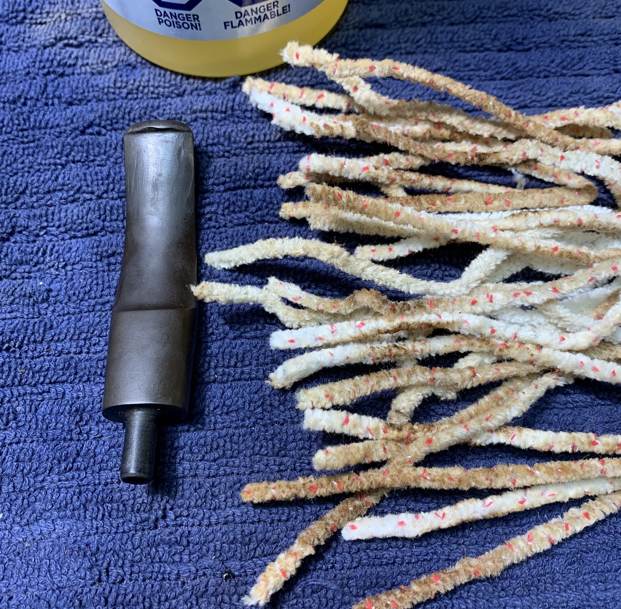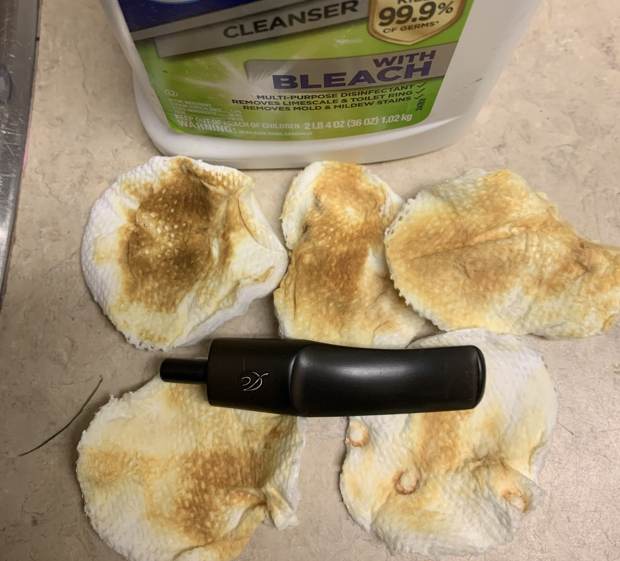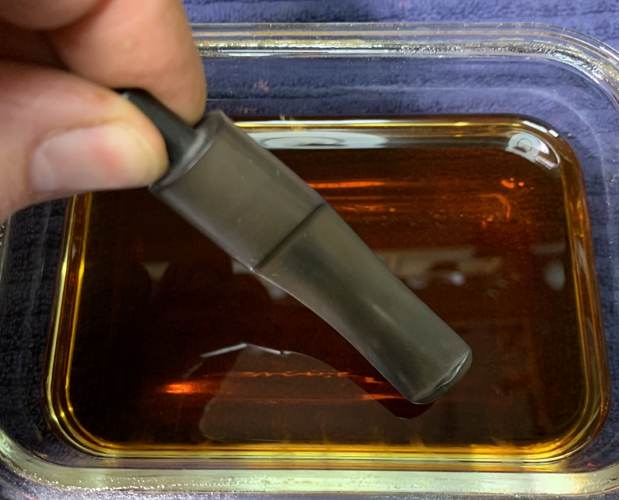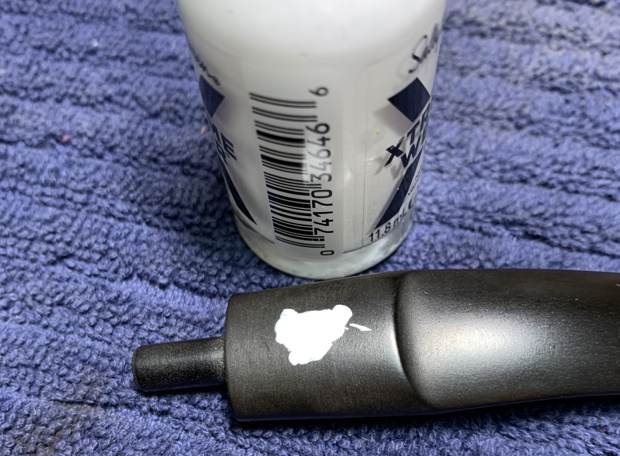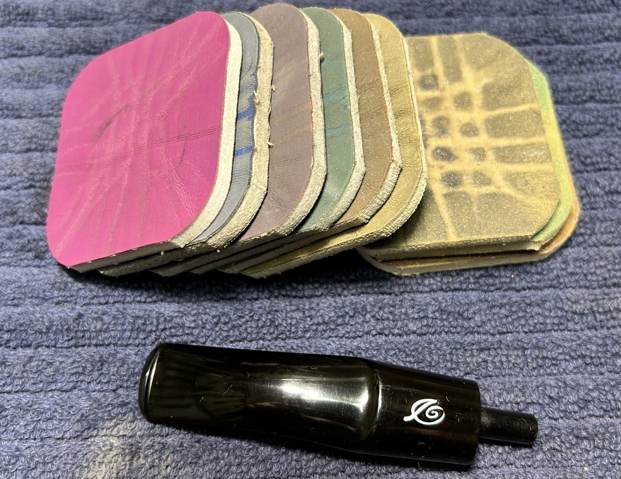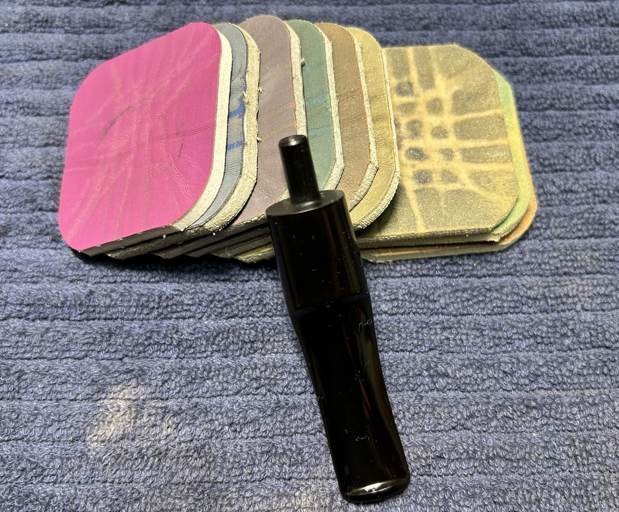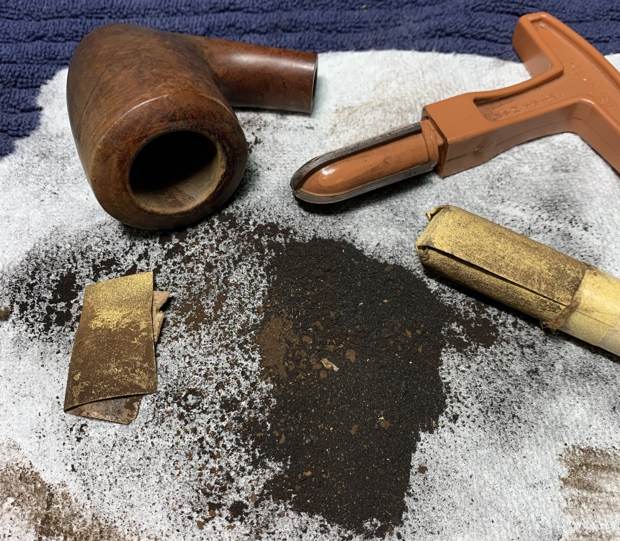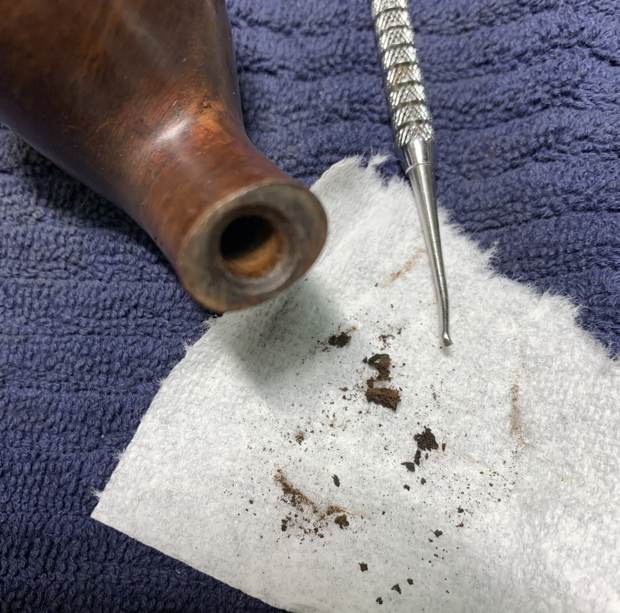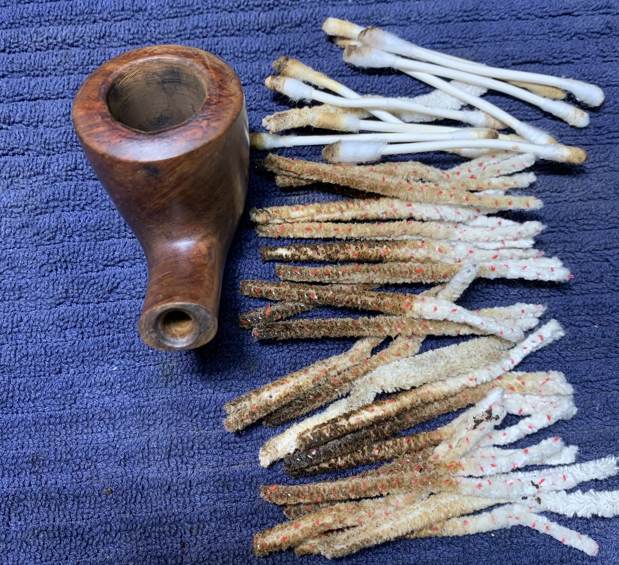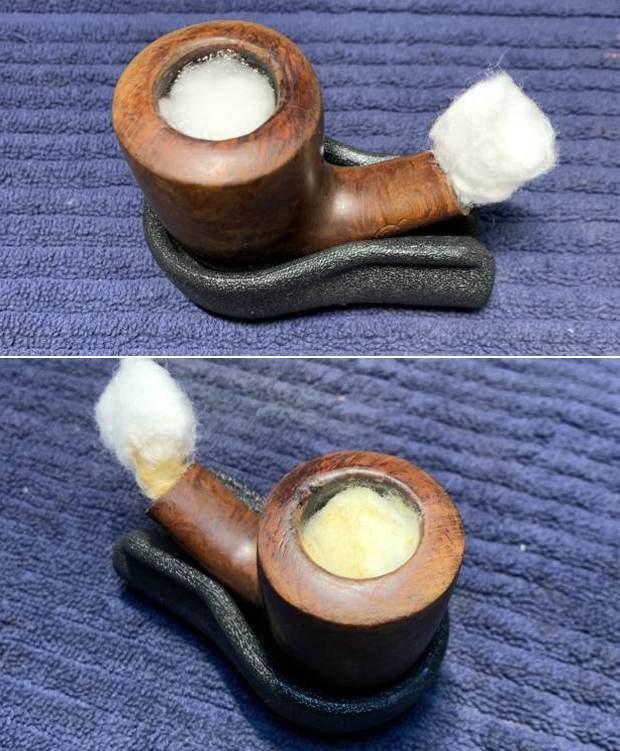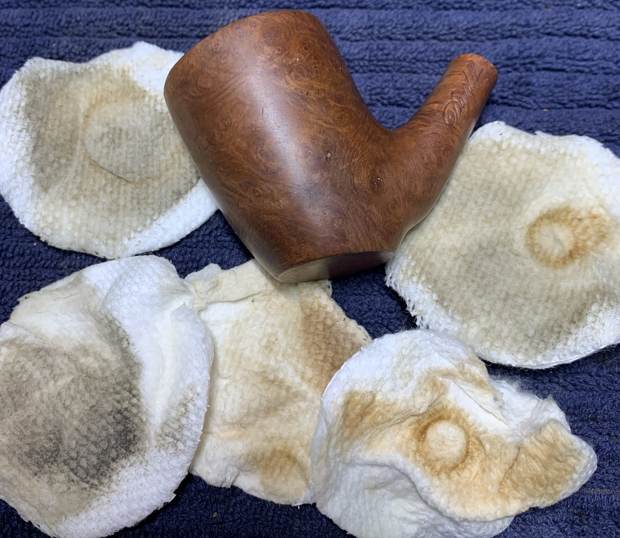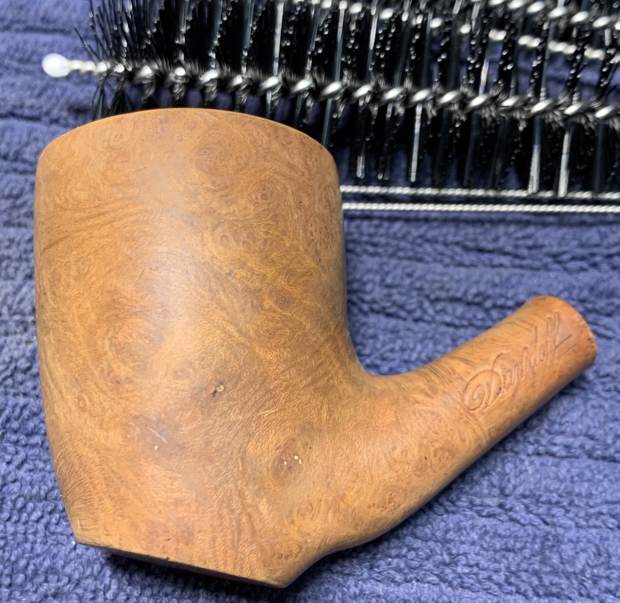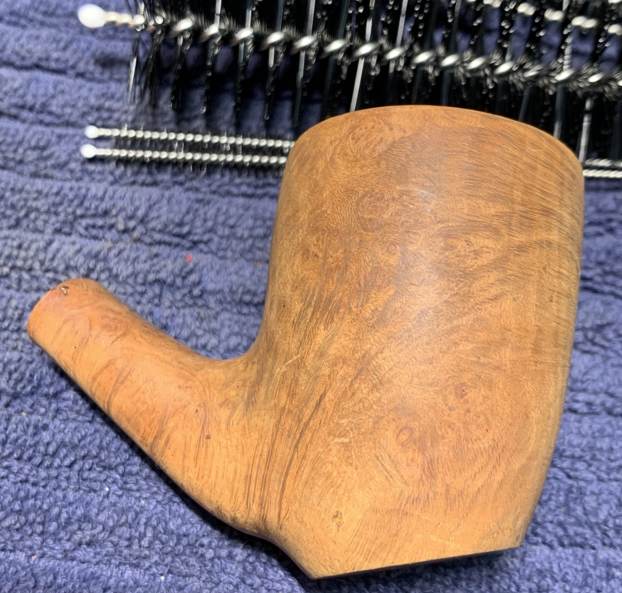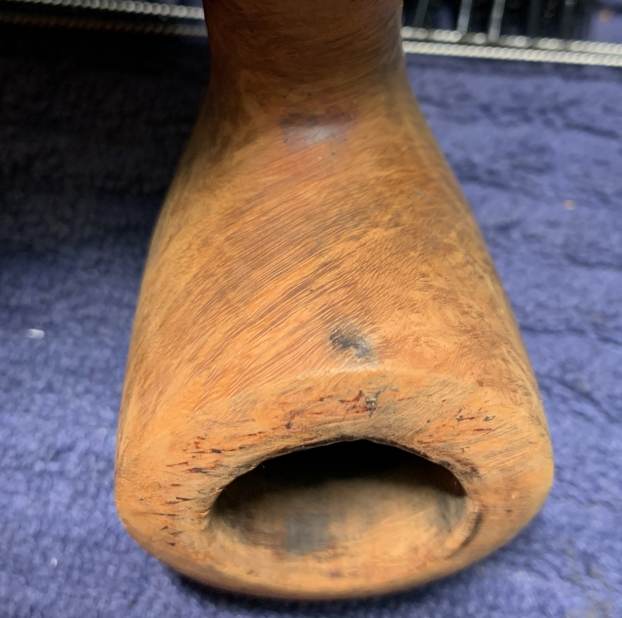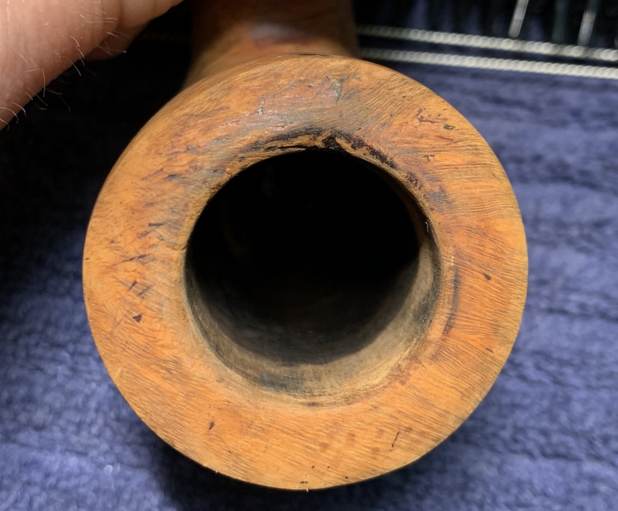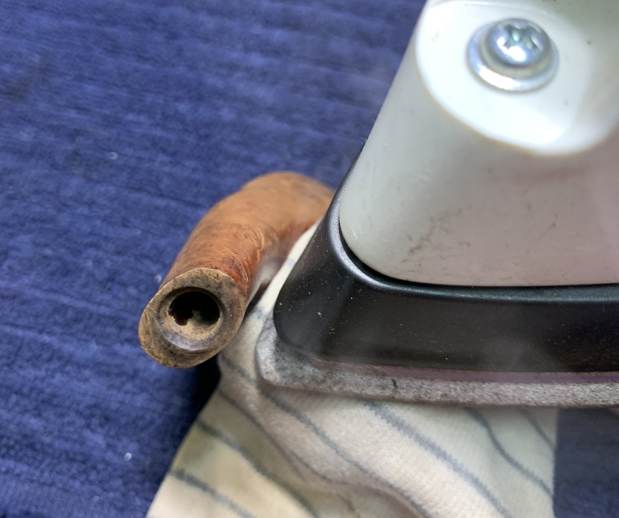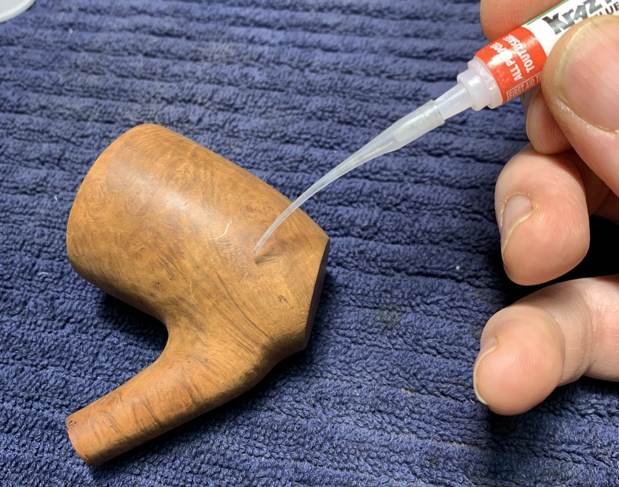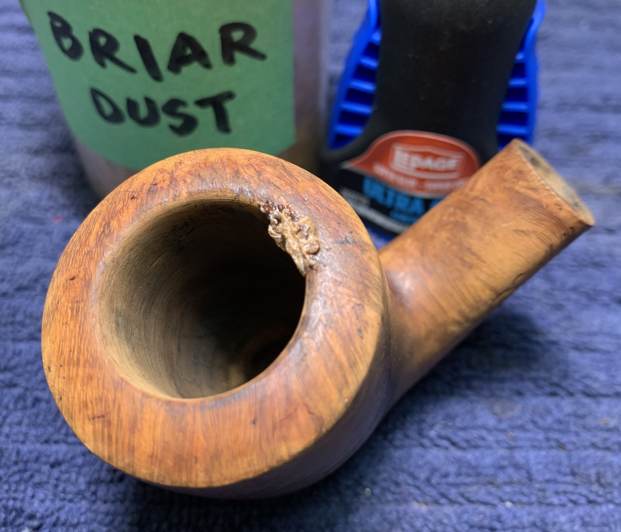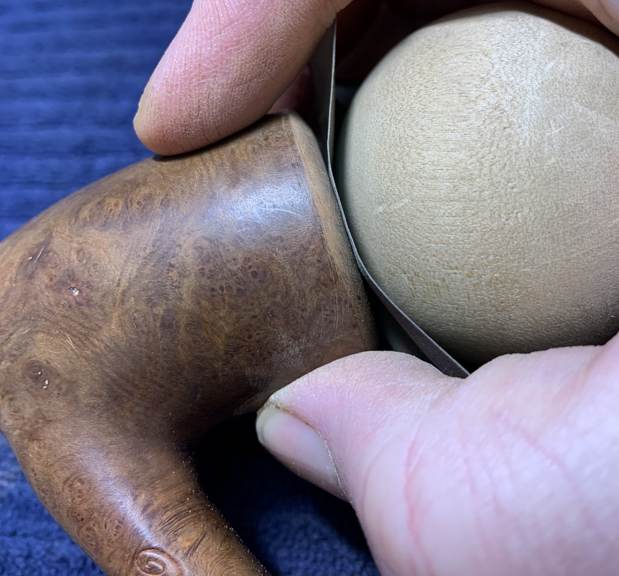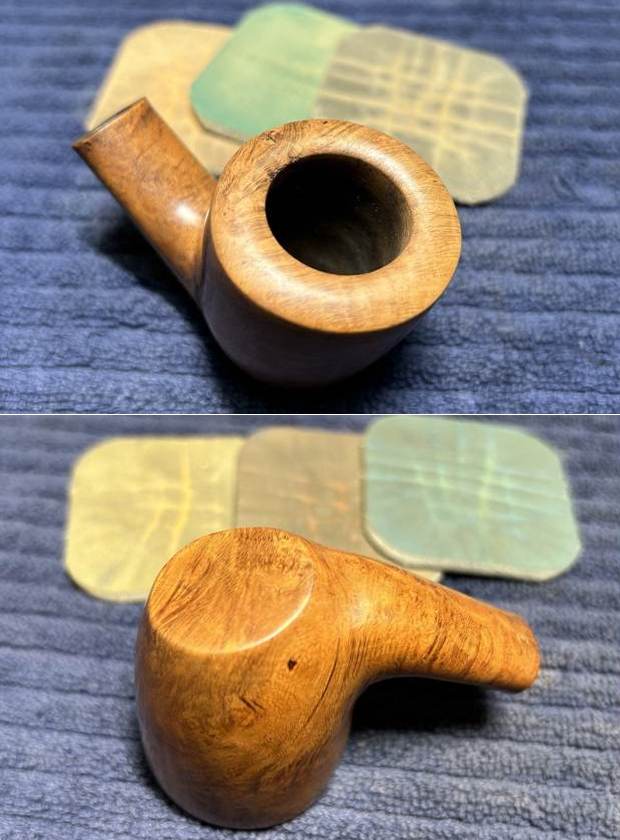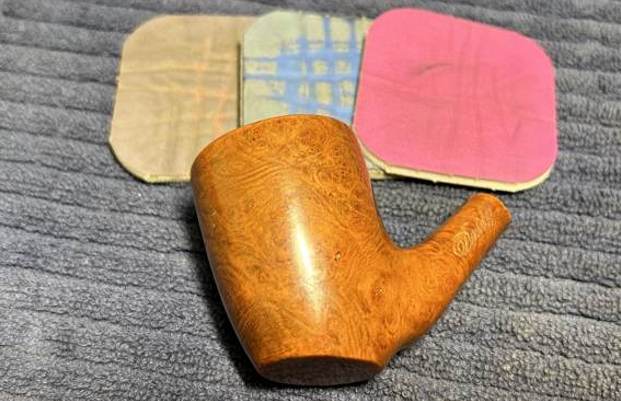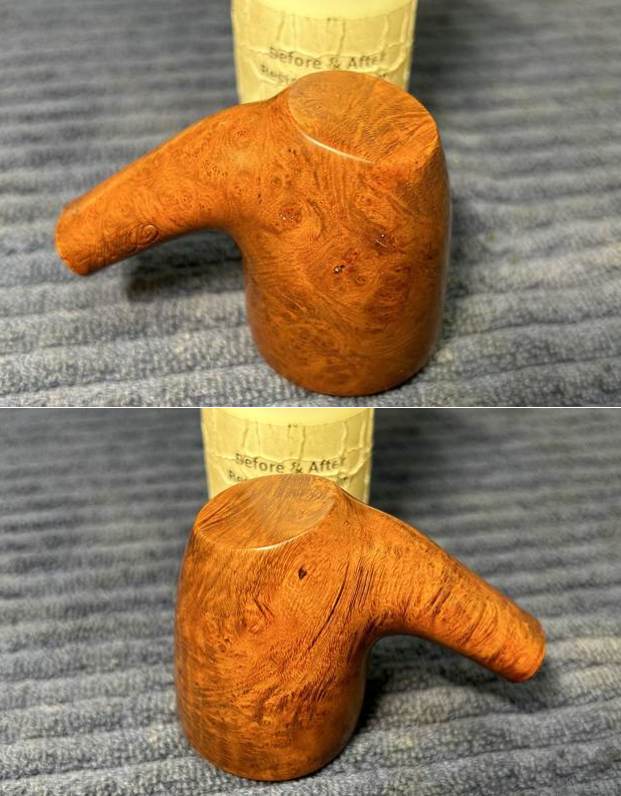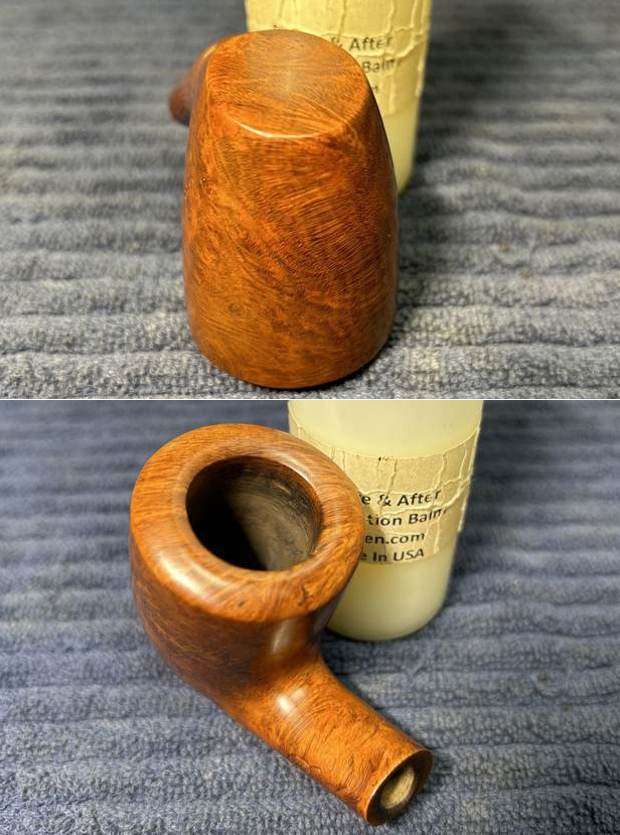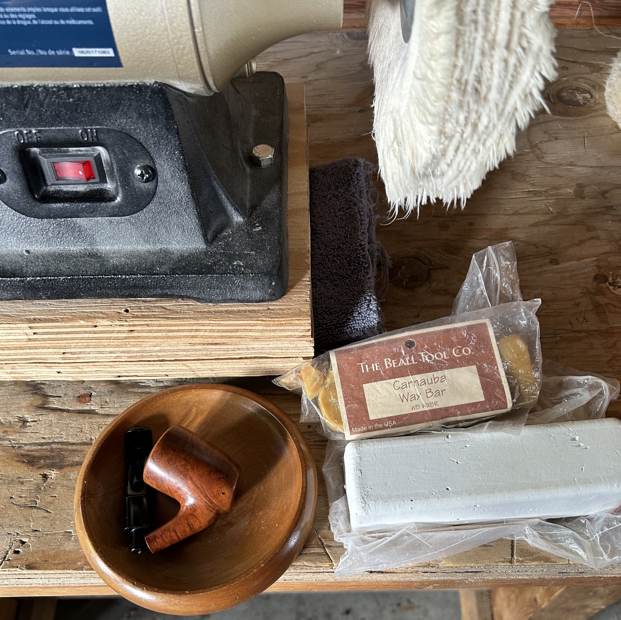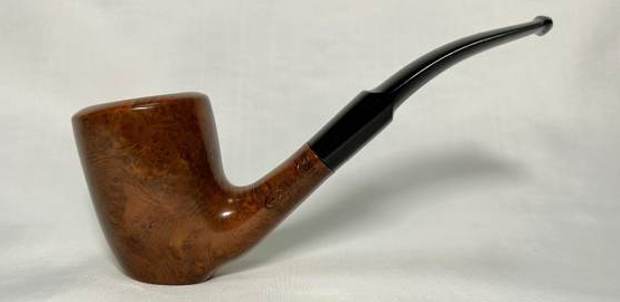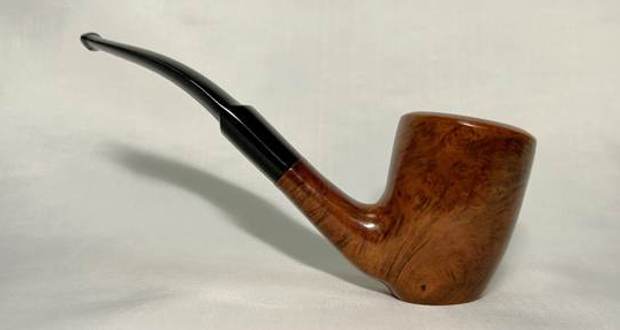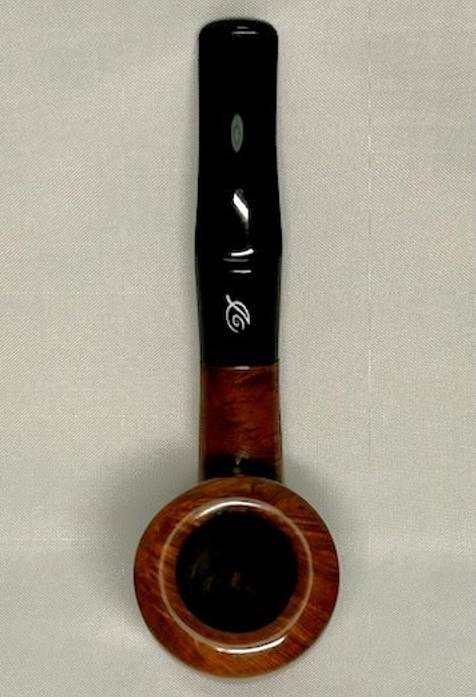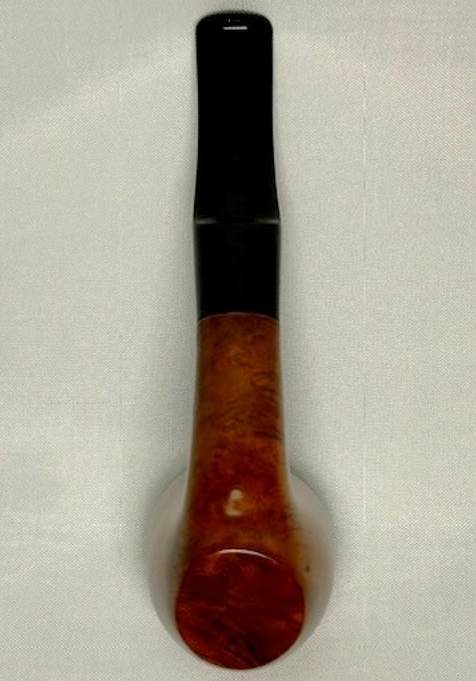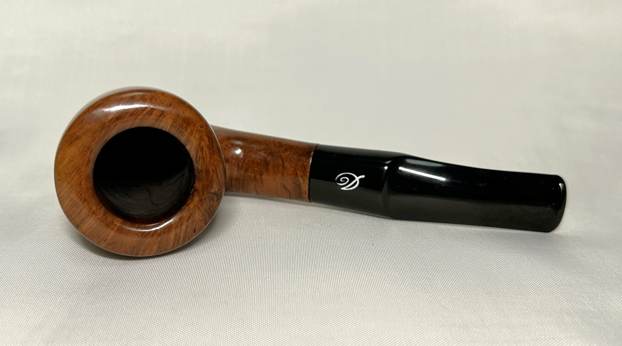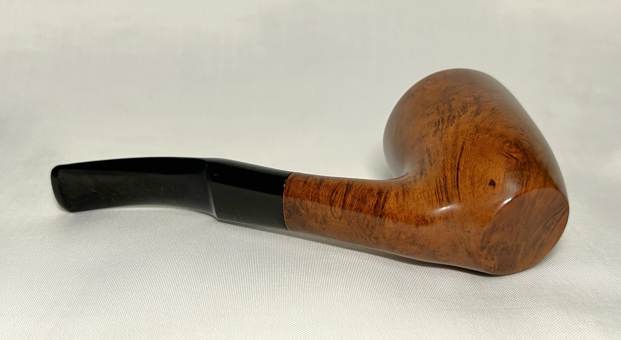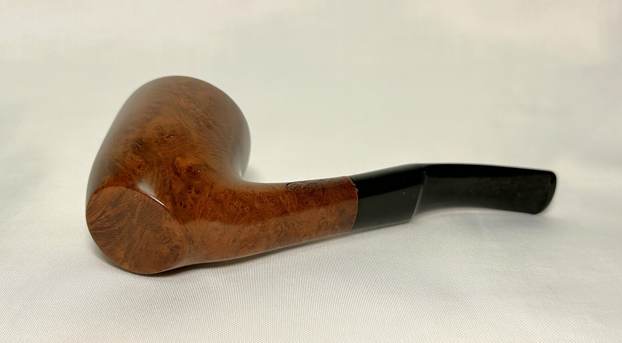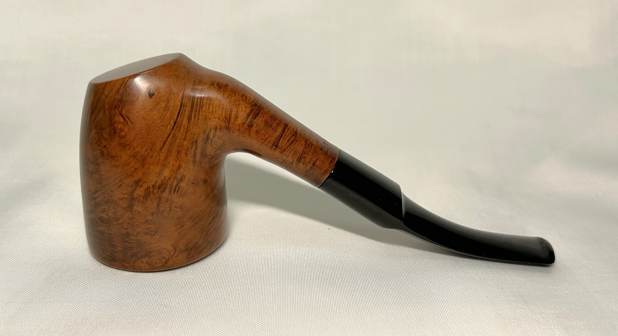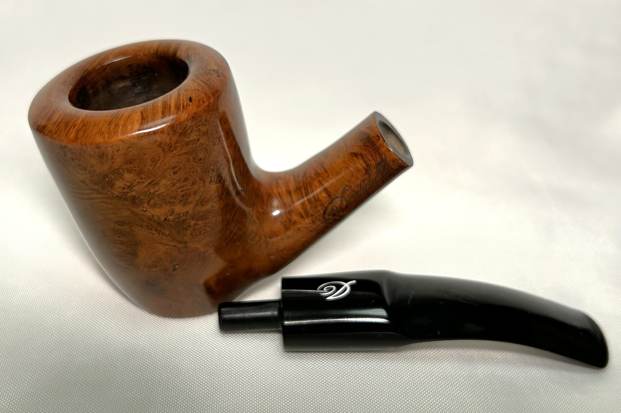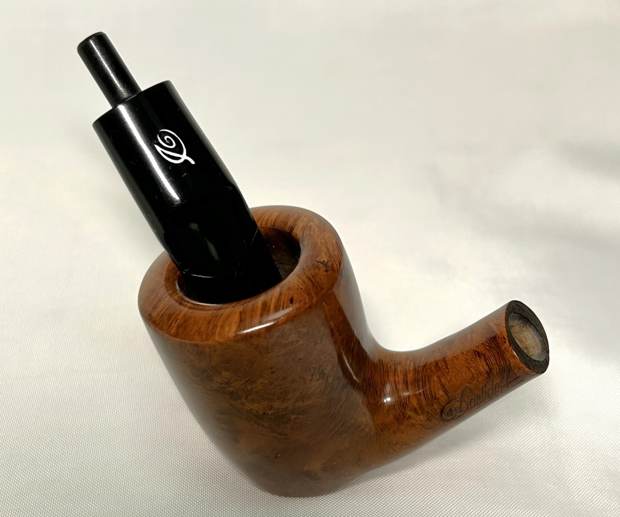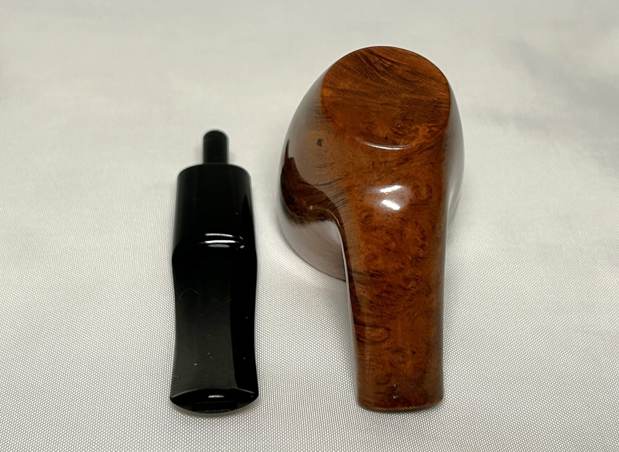Blog by Steve Laug
The next pipe on the table is a nice looking smooth Canadian with a vulcanite taper stem. We picked it up on 04/09/2022 from a seller in Cleveland, Ohio, USA. The stamping on the underside of the shank is faint but still readable. It read L in a circle followed by Charatan’s Make [over] London England. That is followed by the stamping of the shape number 75X. The black vulcanite saddle stem stamped with a CP on the left side. The pipe has a medium reddish brown finish that shows the grain patterns through the sandblast on the bowl sides and shank. It is light weight and comfortable pipe to hold. Jeff sent me the following photos of the pipe to show the condition it was in before he worked on it. This is what I saw when I looked over the pipe.
- The sandblast finish had thick grime ground into briar around the sides. The stain is dull and the grain patterns though visible under the grime are obscured around the bowl sides and shank. There are oil stains from the previous smokers hands around the sides of the bowl.
- The rim top was very dirty with a heavy lava coat on it. It is heavier on the back side. The inner edge of the bowl and top show damage though it is hard to see the extent through the thick build up of cake that has overflown the bowl top.
- There was a thick cake in the bowl. The bowl itself was very dark and dirty. Once the bowl was cleaned up we could confirm the condition of the bowl walls.
- The vulcanite saddle stem was filthy, oxidized, calcified and had tooth marks and chatter on both sides and on the button surface.
- There is a Charatan CP logo stamped on the left side of the stem. It is faint but readable.
To summarize what I saw – this Charatan’s Make Sandblast 75X is a well-made pipe. The bowl and stem are very dirty which says to me that the pipe was once again someone’s favourite pipe. The look and feel of the pipe in the hand is great. It should clean up very well. Here are photos of the pipe taken before Jeff started the clean up.  Jeff took close up photos so that I could have a clearer picture of the condition of the bowl, rim edges and top. The rim top photos confirm my assessment above. The cake in the bowl is thick – covering the walls of the bowl. The rim top has thick lava coat overflowing and covering the inner edge. It is heavier toward the back of the bowl. It is hard to know the condition of the inner edge in this condition. There appears to be some damage on the top and inner edge on the front and the back but I would not know for sure until it was reamed. This is what I look for when assessing a pipe. I look forward to viewing it in person after the clean up work.
Jeff took close up photos so that I could have a clearer picture of the condition of the bowl, rim edges and top. The rim top photos confirm my assessment above. The cake in the bowl is thick – covering the walls of the bowl. The rim top has thick lava coat overflowing and covering the inner edge. It is heavier toward the back of the bowl. It is hard to know the condition of the inner edge in this condition. There appears to be some damage on the top and inner edge on the front and the back but I would not know for sure until it was reamed. This is what I look for when assessing a pipe. I look forward to viewing it in person after the clean up work.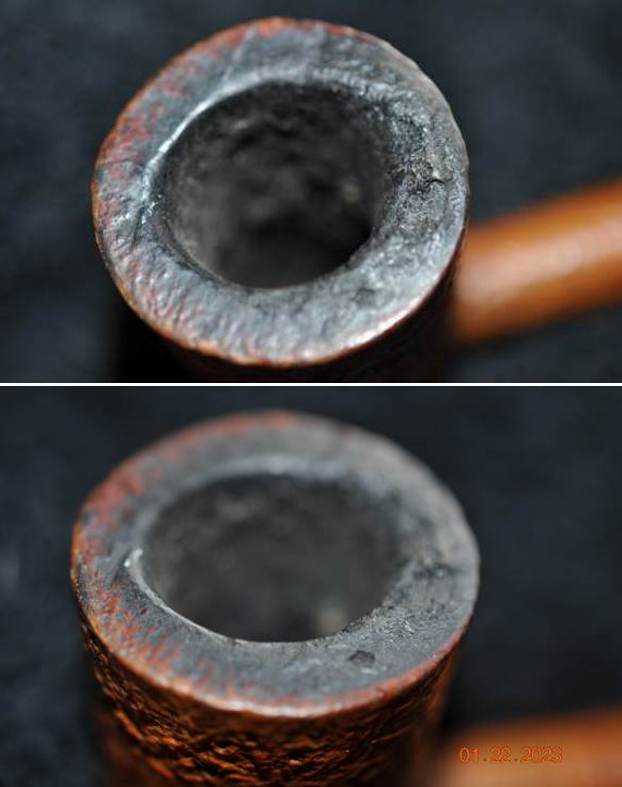 The vulcanite saddle stem is dirty, oxidized and calcified. There are light tooth marks and chatter on both sides ahead of the button.
The vulcanite saddle stem is dirty, oxidized and calcified. There are light tooth marks and chatter on both sides ahead of the button. 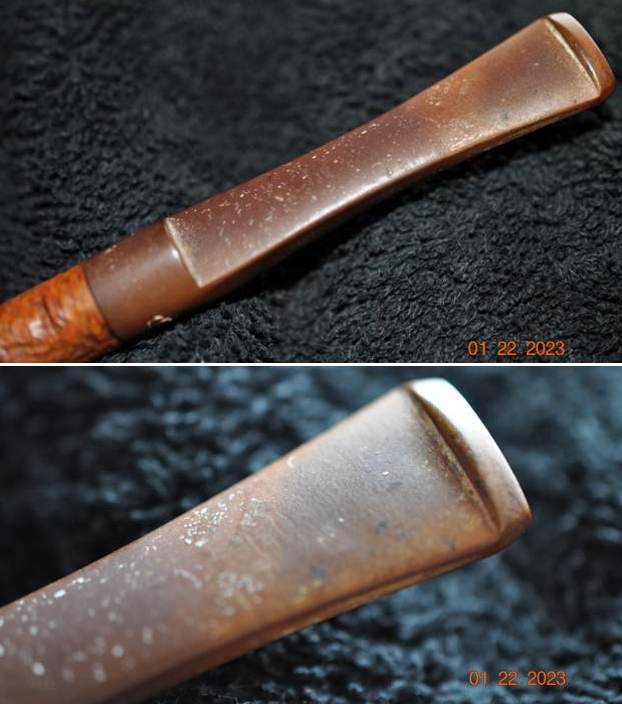
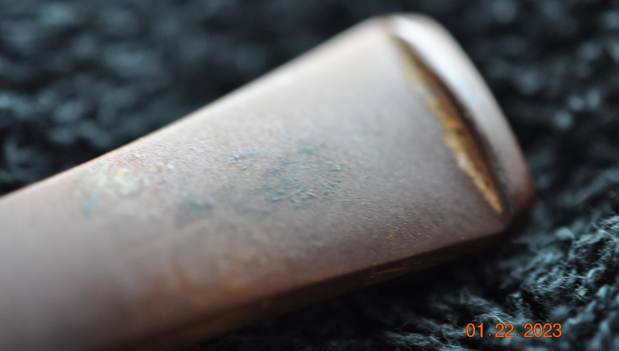 Instead of telling you what I see in the next photos of the sides of the bowl and the heel I want to hear from you. Tell me what you see? What does the finish look like to you? Are there any visible problems or issues that stand out to you? Are there cracks or scratches in nooks and crannies of the sandblast finish of the bowl? Are there visible flaws or fissures in the briar? What does the finish look like? Is there a pattern to it? Any visible issues on the heel of the bowl? These questions should help you to see what I am looking for when I see these photos.
Instead of telling you what I see in the next photos of the sides of the bowl and the heel I want to hear from you. Tell me what you see? What does the finish look like to you? Are there any visible problems or issues that stand out to you? Are there cracks or scratches in nooks and crannies of the sandblast finish of the bowl? Are there visible flaws or fissures in the briar? What does the finish look like? Is there a pattern to it? Any visible issues on the heel of the bowl? These questions should help you to see what I am looking for when I see these photos. 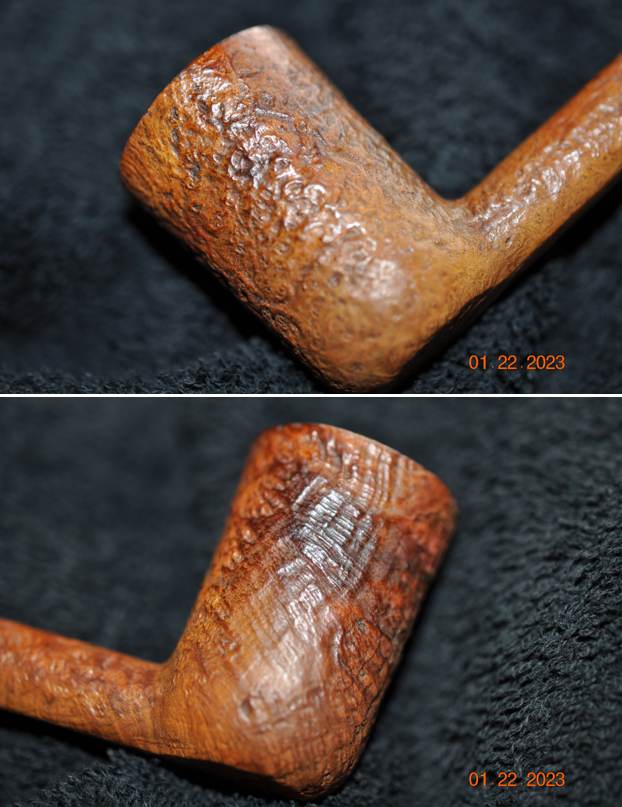
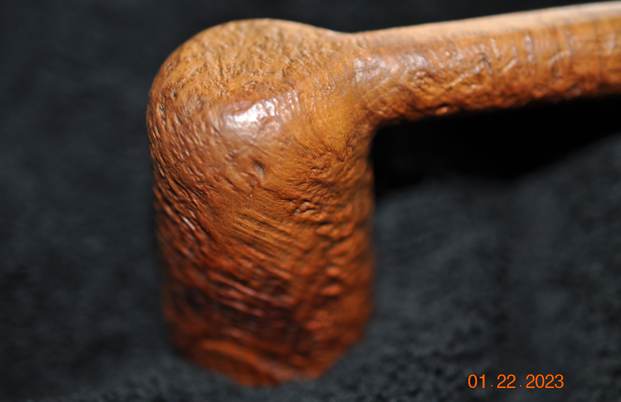 He took photos of the stamping on the underside of the shank. It is stamped as noted above. The vulcanite stem shows a CP stamp on the left side. What stands out for you in the photos of the stamping? What do you look for in the stamping? It is dirty but what do you see underneath the grime on the surface of the briar?
He took photos of the stamping on the underside of the shank. It is stamped as noted above. The vulcanite stem shows a CP stamp on the left side. What stands out for you in the photos of the stamping? What do you look for in the stamping? It is dirty but what do you see underneath the grime on the surface of the briar?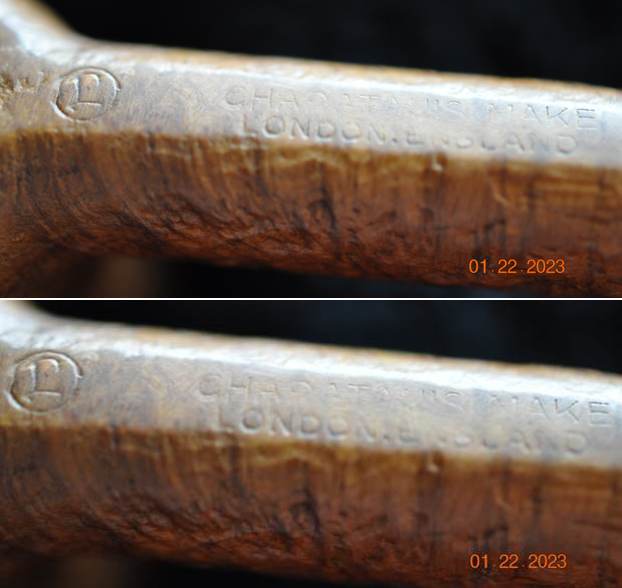
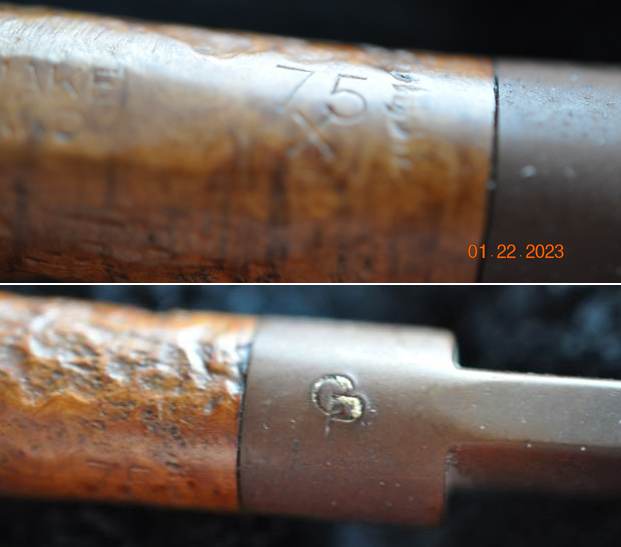 I turned to Pipephil’s site (http://pipephil.eu/logos/en/logo-charatan.html) to look up information on the pipe but there was nothing specific.
I turned to Pipephil’s site (http://pipephil.eu/logos/en/logo-charatan.html) to look up information on the pipe but there was nothing specific.
I also turned to Pipedia (https://pipedia.org/wiki/Dating_of_Charatans) to help with dating it. I quote the section of the article that applies to this pipe below.
Identification of a third era pipe (First Lane era, 1961-1965)
Pipes of this period are quite common.
1) The mouthpiece is frequently double comfort, rarely saddle without the double comfort, never tapered. If the stem is not a double comfort but a saddle one, it is characterized by the letter X on the right of the shape code (e.g. 2502X), naturally in this case the letters DC are not displayed.
2) In the CP logo, the C enters the P
3) Presence of £ on the shank (note that from 1955 all the pipe imported in the USA by Lane has it, however that stamping is not synonymous of the Lane era)
4)Presence of the letter DC just after the shape number (e.g. 2502 DC) or of the letter X only if the stem is not a double comfort one
5) Presence in some models of the stamp “MADE BY HAND” on the shank (introduced for the first time in 1958)
6) Presence of the writing “CHARATAN’S MAKE LONDON ENGLAND” on 2 lines
7) The CP logo is thicker then in previous eras
From the clues listed above regarding the stamping on the shank underside, I am fairly confident it is a First Lane Era pipe made between 1961-1965. Knowing that it is time to work on it.
Jeff did a major clean up job on this one and the pipe I received when it arrived in Vancouver looked far better than the one pictured above. Here is what I saw when I brought the pipe to the table.
- The sandblast finish is clean and the oils and grime are gone from the bowl. The finish shows the beautiful contrast in the stains in the sandblast finish around the bowl and shank.
- The rim top was clean of the thick lava. The top and the inner edge of the bowl showed burn damage on the front and back top and edges of the bowl.
- There cake in the bowl has been removed and the bowl is very clean. The walls of the bowl are smooth and appear to be undamaged and show no checking or burn damage.
- The vulcanite saddle stem looks better though there is still some oxidation and light tooth marks and chatter on both sides.
- The Charatan CP logo stamped on the left side of the stem looks very clean and readable.
Hopefully the steps above show you both what I look for when I go over the pipe when I bring it to the work table and also what I see when I look at the pipe in my hands. They also clearly spell out a restoration plan in short form. My work is clear and addressing it will be the next steps. I took photos of the whole pipe to give you a picture of what I see when I have it on the table. This is important to me in that it also shows that there was no damage done during the clean up work or the transit of the pipe from Idaho to here in Vancouver. 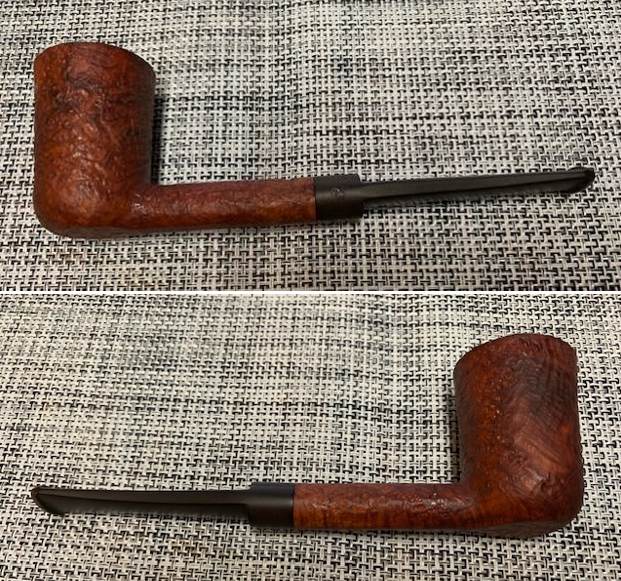
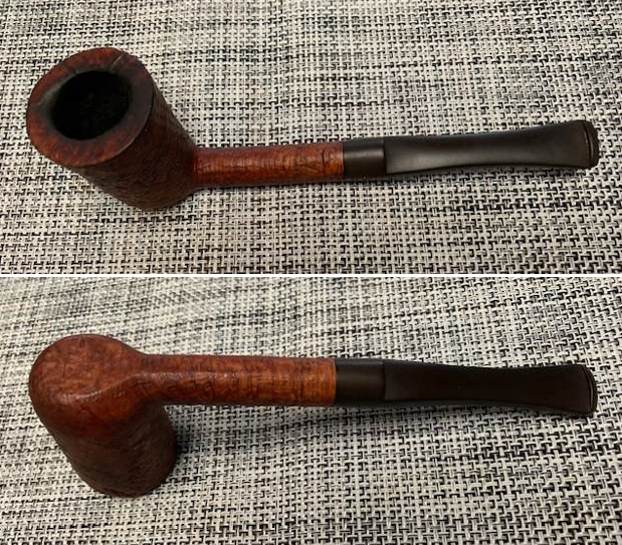 I carefully went over the bowl and rim top to get a sense of what is happening there. In this case once the rim top and edges were cleaned the rim top looked better. The inner edge was in good condition and looked good with the rusticated plateau style rim top. I also went over the stem carefully. The fit of the replacement to the shank is snug and the transitions are smooth. There were some tooth marks and chatter on the surface of the stem and the button on the underside. The acrylic stem surface was clean and looked better. I took photos of the rim top and stem sides to show as best as I can what I see when I look at them.
I carefully went over the bowl and rim top to get a sense of what is happening there. In this case once the rim top and edges were cleaned the rim top looked better. The inner edge was in good condition and looked good with the rusticated plateau style rim top. I also went over the stem carefully. The fit of the replacement to the shank is snug and the transitions are smooth. There were some tooth marks and chatter on the surface of the stem and the button on the underside. The acrylic stem surface was clean and looked better. I took photos of the rim top and stem sides to show as best as I can what I see when I look at them. 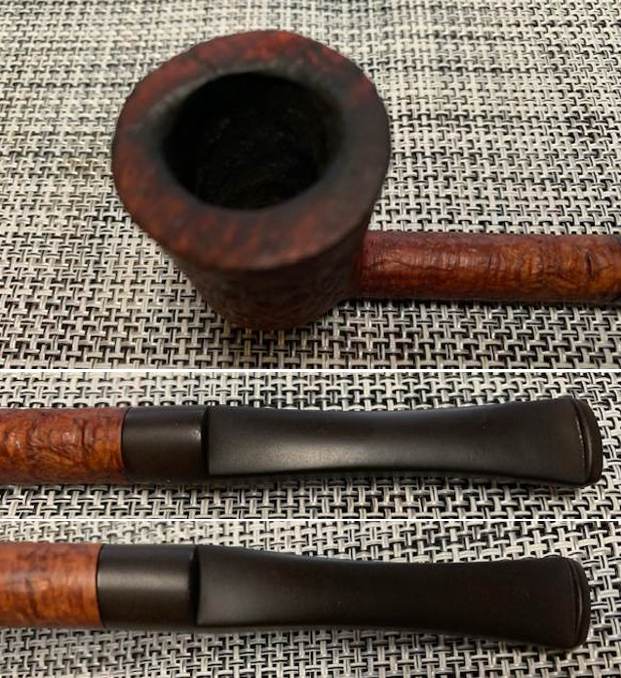 I always check to make sure that the clean up work did not damage the stamping on the shank sides in any way. It is in faint as it was earlier but it is readable. I love just looking at the lay of the pipe and the proportion of the hand made pipes. I took the pipe apart to get a sense of what was in the mind of the pipe maker when he crafted the pipe. The photo shows its beauty in flow and shape.
I always check to make sure that the clean up work did not damage the stamping on the shank sides in any way. It is in faint as it was earlier but it is readable. I love just looking at the lay of the pipe and the proportion of the hand made pipes. I took the pipe apart to get a sense of what was in the mind of the pipe maker when he crafted the pipe. The photo shows its beauty in flow and shape.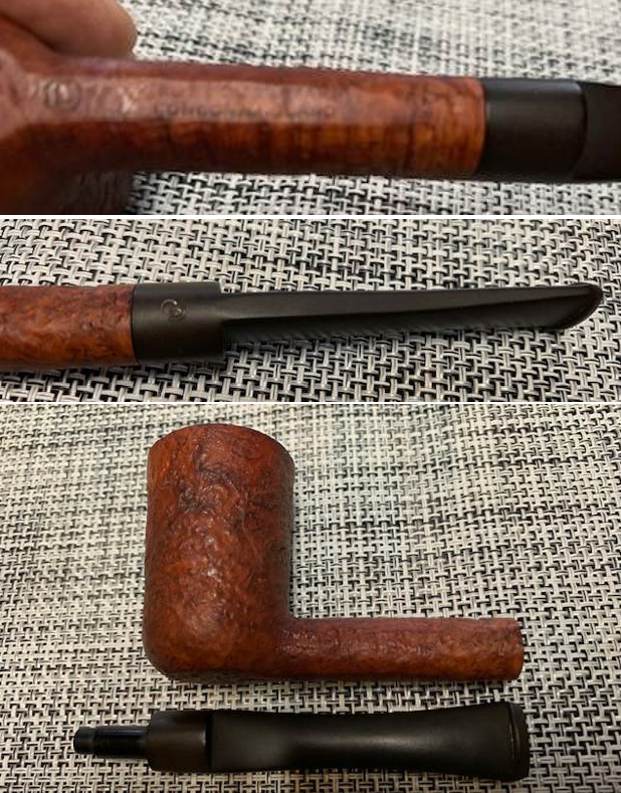 I decided to start my work on the pipe by addressing the damage to the rim top and inner edge of the bowl. The burn damage is quite wildly spread. The rim top had a light bevel so I would need to give it a deeper bevel to remove the damage and blend it in better. The top itself had some darkening but it was sandblast so I had to try to minimize it as best as possible.
I decided to start my work on the pipe by addressing the damage to the rim top and inner edge of the bowl. The burn damage is quite wildly spread. The rim top had a light bevel so I would need to give it a deeper bevel to remove the damage and blend it in better. The top itself had some darkening but it was sandblast so I had to try to minimize it as best as possible. I used a Maple stain pen to touch up the inner edge of the bowl and the rim top and blend it into the surrounding briar. It looked much better once it was restained. The burn damage is less prevalent and visible.
I used a Maple stain pen to touch up the inner edge of the bowl and the rim top and blend it into the surrounding briar. It looked much better once it was restained. The burn damage is less prevalent and visible. 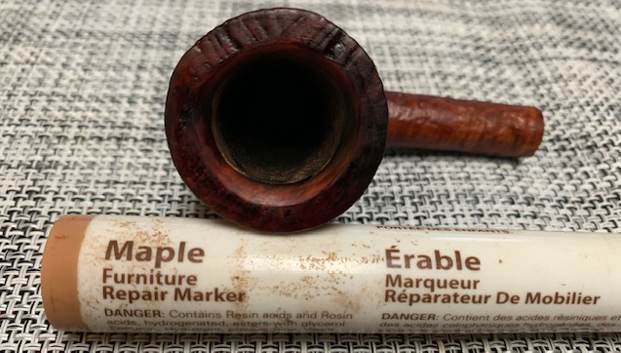 I rubbed down the bowl and shank with Before & After Restoration Balm. It is a paste/balm that is rubbed into the surface of the briar. The product works to deep clean the finish, enliven and protect the briar. I worked it into the briar with my finger tips and a horsehair shoe brush. I let it sit for 10 minutes then wiped it off with a soft cloth then buffed it with a cotton cloth. The briar really began to have a deep shine in the briar and the sandblast showed depth. The photos I took of the bowl at this point mark the progress in the restoration. It is a great looking pipe.
I rubbed down the bowl and shank with Before & After Restoration Balm. It is a paste/balm that is rubbed into the surface of the briar. The product works to deep clean the finish, enliven and protect the briar. I worked it into the briar with my finger tips and a horsehair shoe brush. I let it sit for 10 minutes then wiped it off with a soft cloth then buffed it with a cotton cloth. The briar really began to have a deep shine in the briar and the sandblast showed depth. The photos I took of the bowl at this point mark the progress in the restoration. It is a great looking pipe. 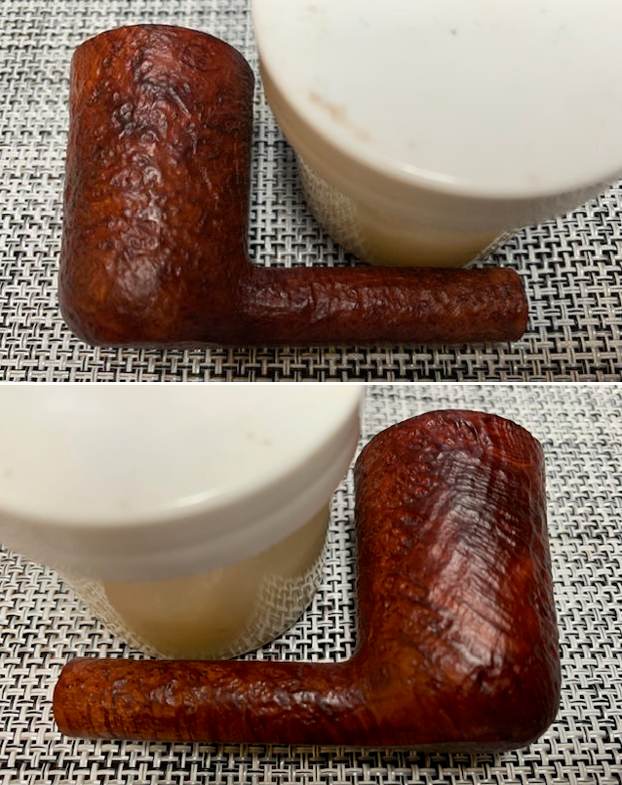
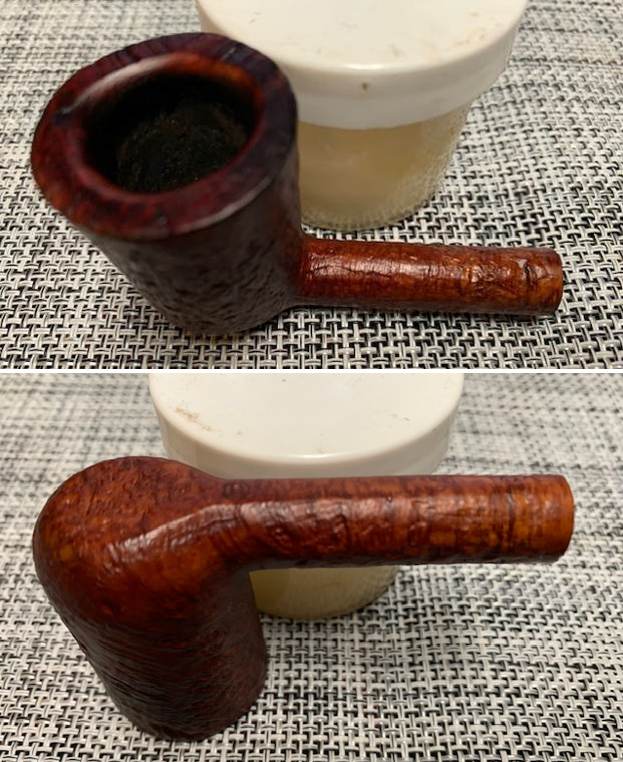
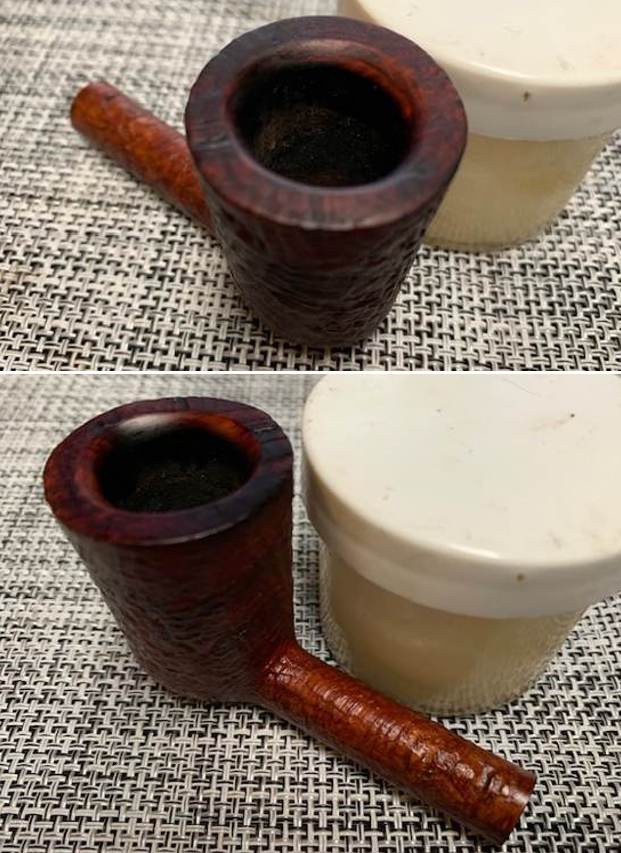 I set the bowl aside and turned to the stem. I decided to deal with the residual oxidation first. I wiped the stem down with Soft Scrub cleanser to remove the remaining oxidation on the stem surface. It looked much better.
I set the bowl aside and turned to the stem. I decided to deal with the residual oxidation first. I wiped the stem down with Soft Scrub cleanser to remove the remaining oxidation on the stem surface. It looked much better. 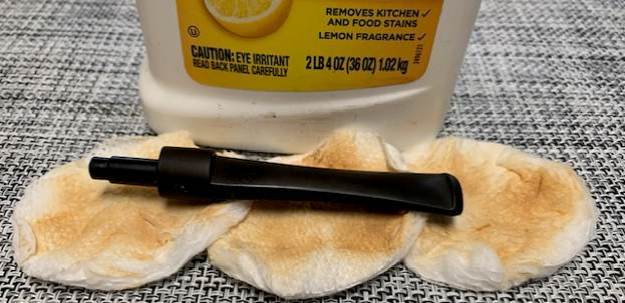 I touched up the faint CP stamping on the left side of the stem with White Acrylic Fingernail Polish.
I touched up the faint CP stamping on the left side of the stem with White Acrylic Fingernail Polish. 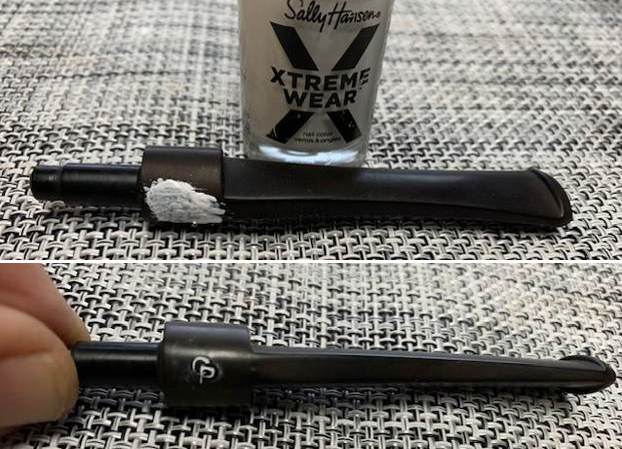 I polished the stem with micromesh sanding pads – 1500-12000 grit sanding pads and water to wet sand the stem. I wiped it down after each sanding pad with Obsidian Oil on a cotton rag after each sanding pads. I know that many say Obsidian Oil does nothing for acrylic stems, but I find it does two things – first it gives some protection to the stem from buildup and second it give the sanding pads bite in the polishing process.
I polished the stem with micromesh sanding pads – 1500-12000 grit sanding pads and water to wet sand the stem. I wiped it down after each sanding pad with Obsidian Oil on a cotton rag after each sanding pads. I know that many say Obsidian Oil does nothing for acrylic stems, but I find it does two things – first it gives some protection to the stem from buildup and second it give the sanding pads bite in the polishing process. 
 After finishing with the micromesh pads I rub the stem down with Before & After Fine and Extra Fine stem polish as it seems to really remove the fine scratches in the acrylic. I rub the Fine Polish on the stem and wipe it off with a paper towel and then repeat the process with the Extra Fine polish. I finish the polishing of the stem down with a final coat of Obsidian Oil and set the stem aside to let the oil absorb. This process gives the stem a shine and also a bit of protection.
After finishing with the micromesh pads I rub the stem down with Before & After Fine and Extra Fine stem polish as it seems to really remove the fine scratches in the acrylic. I rub the Fine Polish on the stem and wipe it off with a paper towel and then repeat the process with the Extra Fine polish. I finish the polishing of the stem down with a final coat of Obsidian Oil and set the stem aside to let the oil absorb. This process gives the stem a shine and also a bit of protection.  The final steps in my process involve using the buffer. I buffed the stem with Blue Diamond to polish out the light scratches in the vulcanite. I don’t buff a sandblast bowl with Blue Diamond as it can easily clog the valley and crannies in the blast. I gave the bowl multiple coats of Conservator’s Wax and the stem multiple coats of carnauba wax. I have found that I can get a deeper shine if I follow up the wax buff with a buff with a clean buffing pad. It works to raise the shine and then I hand buff with a microfiber cloth to deepen the shine. It is always fun for me to see what the polished bowl looks like with the polished stem. It really is a nice pipe. The smooth finish around the bowl sides and shank looks great. The vulcanite saddle DC stem works well with the pipe. The sandblast Charatan’s Make London England 75X feels great in my hand. It is a well-balanced pipe. Have a look at it with the photos below. The dimensions are Length: 5 ½ inches, Height: 2 inches, Outside diameter of the bowl: 1 ¼ inches, Chamber diameter: ¾ inch. The weight of the pipe is 1.41 ounces/40 grams. It is a beautiful pipe that I will soon be adding to the rebornpipes store in the British Pipemakers Section. If you would like to add it to your collection let me know. It should be a great smoking pipe.
The final steps in my process involve using the buffer. I buffed the stem with Blue Diamond to polish out the light scratches in the vulcanite. I don’t buff a sandblast bowl with Blue Diamond as it can easily clog the valley and crannies in the blast. I gave the bowl multiple coats of Conservator’s Wax and the stem multiple coats of carnauba wax. I have found that I can get a deeper shine if I follow up the wax buff with a buff with a clean buffing pad. It works to raise the shine and then I hand buff with a microfiber cloth to deepen the shine. It is always fun for me to see what the polished bowl looks like with the polished stem. It really is a nice pipe. The smooth finish around the bowl sides and shank looks great. The vulcanite saddle DC stem works well with the pipe. The sandblast Charatan’s Make London England 75X feels great in my hand. It is a well-balanced pipe. Have a look at it with the photos below. The dimensions are Length: 5 ½ inches, Height: 2 inches, Outside diameter of the bowl: 1 ¼ inches, Chamber diameter: ¾ inch. The weight of the pipe is 1.41 ounces/40 grams. It is a beautiful pipe that I will soon be adding to the rebornpipes store in the British Pipemakers Section. If you would like to add it to your collection let me know. It should be a great smoking pipe.
As always I encourage your questions and comments as you read the blog. Thanks to each of you who are reading this blog. Remember we are not pipe owners; we are pipe men and women who hold our pipes in trust until they pass on into the trust of those who follow us.
















